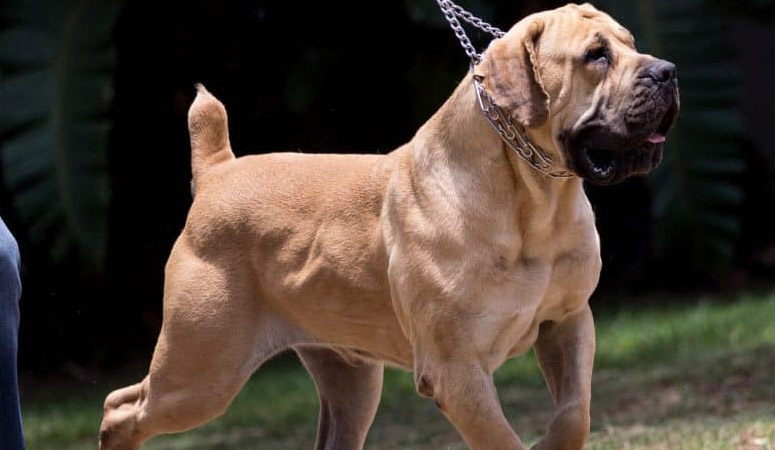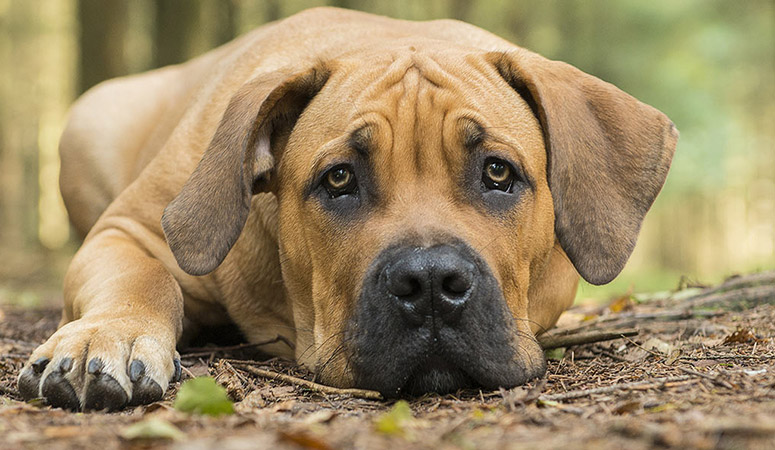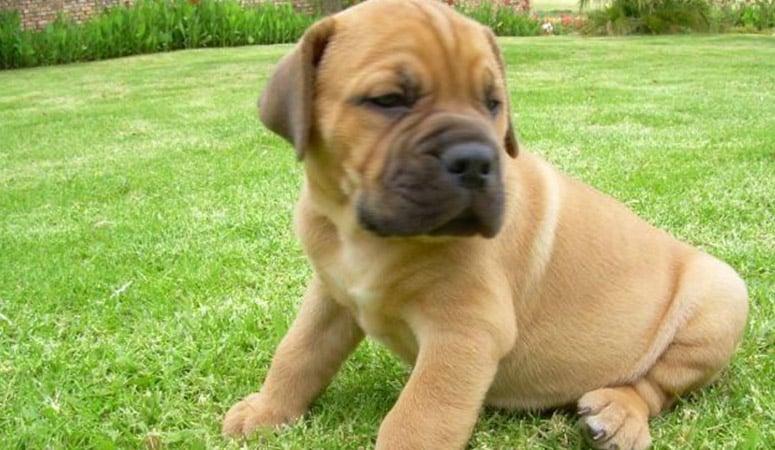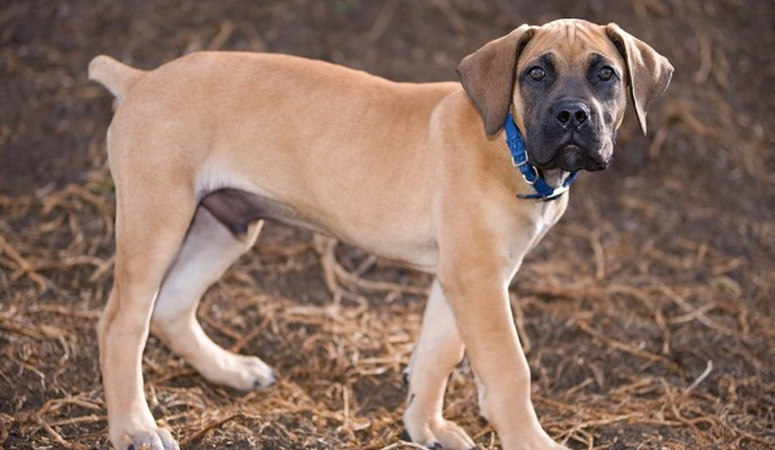Boerboel
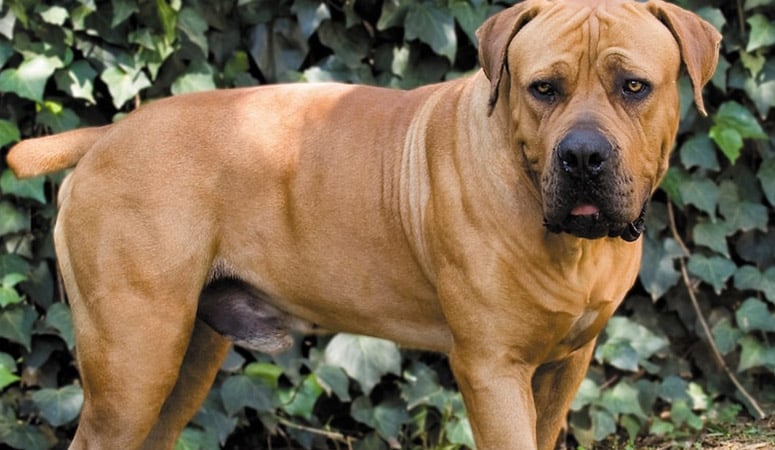
The Boerboel is a large, mastiff-type dog breed from South Africa where they were bred for the purpose of guarding the homestead and working the farm. They are excellent guard dogs and also known for being calm, family-friendly, especially towards human children.
| Other Names | South African Boerboel, South African Mastiff |
| Color | Brindle, Brown, Cream, Red, Reddish Brown, Tawny |
| Height | Males: 24-28 inches. Females: 22-26 inches. |
| Weight | Males: 150-200 pounds. Females: 150-200 pounds. |
| Life Span | 9-11 years |
| Personality | Confident, Intelligent, Calm |
| Exercise | Calm |
| Origin |
| Popularity | #127 |
| Groom Needs | Occasional |
| Kids Friendly | Yes with supervision |
| Dog Friendly | Yes with supervision |
| Watch Dog | Yes |
| Family Dog | |
| Litter Size | 7-10 |
Boerboel Pictures
Boerboel Video
Introduction
Large, stocky build complemented with symmetry and remarkable balance, is rather an incomplete description of this giant South African dog. They present physically in a double coat that doesn’t shed easily, the topcoat which is normally coarse and straight covers a soft and dense undercoat. Boerboels come in different color varieties, of which the fawn, brindle, and brown, and black are well recognized. Some may have a black mask around their mouth or eyes.
The male Boerboels are significantly larger than the females, appearing 25-28 inches tall measured at the shoulder, where a standard females measures around 24-26 inches. A full-grown male normally weighs within the range of 140-175 pounds, where a similar female would likely weigh 110-140 pounds. They are calm, intelligent, and walk with an air of confidence about them. Boerboels have an average life expectancy of 8-11 years.
Living with Boerboel
The Boerboel’s coat sheds an average amount and doesn’t need much care. It is required weekly brushing with a soft-bristle brush, a rubber grooming mitt, or a hound glove to help remove any loose hair and keep the dog looking best. And a good brushing is helpful to promote new hair growth and distributes skin oils throughout the coat to keep it healthy. A bath once a month, or when your dog gets dirty, is enough to keep your dog clean and pleasant smelling.
Check and clean your dog’s ears every week with a gentle, dog-friendly cleanser to prevent dirt buildup that may cause infections. Also, brush their teeth at least two or three times a week to keep fresh breath and prevent gum disease. Besides, trim the nails every month or so to prevent painful cracking.
The Boerboel requires mentally and physically stimulated through exercise and play. A daily exercise is good for the strong and athletic Boerboel, the owner can take your dog for long walks on a leash or play sessions in a securely and fenced area. It is not advisable to take the Boerboel to visit dog parks because they will not perform kindly to challenges from other dogs. And the Boerboel should never be allowed off-leash because of their protective instinct.
Besides, they are excellent at most dog sports and agility training. They enjoy participating in canine sports such as obedience, rally, weight pull, and agility competitions, as well as protection sports and stock work.
A Boerboel diet should be formulated for a large to giant breed with moderate to high exercise requirements. More importantly, the food amount should depend on the dog’s weight, size, age, and activity level.
Some dogs are easy to get overweight, so you need to watch their calorie consumption and weight level all the time. Treats may be an important aid in training, but excessive intake can lead to obesity. Also, owners need to distinguish which human food is safe for dogs and which are not. If you have any problems with your dog’s weight or diet, just consult from your veterinarian.
The Boerboels are prone to the following health conditions: hip and elbow dysplasia, bloat, heart ailments, eyelids that turn inwards or outwards (ectropion and entropion), etc.
Major concerns: elbow dysplasia, CHD
Minor concerns: entropion, ectropion
Occasionally seen: epilepsy
Suggested tests:
Elbow Evaluation
Hip Evaluation
Ophthalmologist Evaluation
Total Annual Cost: $3536
Cost is estimated for the first year and may vary depending on many factors, such as dog food, health care, leash, collar, licensing, possible fencing, crates, training and obedience classes, dog-walking, grooming, treats, toys, flea, tick, and heart-worm meds, microchips, etc.
The Boerboel is a protective, territorial breed, so it is not a breed for a novice dog owner. And Boerboels are also not easy to be trained as they are strong-willed and dominant. And they must be with their people and will not thrive unless kept as an integral part of their human family.
Firm and consistent training are necessary for this breed, and all training should be done using positive methods and treats based reward system. Harshness or manhandling the Boerboel will only lead to resentment and aggression. And training should be a part of the Boerboel’s daily routine. Besides, advanced obedience training is a must to ensure the Boerboel remembers his manners, and they are capable of participating in dog sports and agility training.
History
The Boerboel is a South African dog of the mastiff type. It was the only breed developed for farm labor in South Africa. The name “Boerboel” translates to ‘Farmer’s Dog’, from words borrowed off the Afrikaans or Dutch. ”Boer” means “farmer”, while “boel” stands for dog. There’s little or no accurate evidence as regards which breeds formed the foundation of the Boer dog. In different parts of South Africa, however, different imported dog breeds were crossed with the indigenous South African dogs, especially the Boerdogs. The early history of the Boerboel is perceived to be linked to the arrival of Jan van Riebeeck in the region of modern-day Cape Town, in the 1650s, with dogs believed to have been Bulldogs. Other scraps of evidence reveal that European settlers around that time had also imported some strong dogs into South Africa. These Dutch and European (especially British and French) dogs were interbred with a good number of the native South African landrace dogs, probably the Africanis. This was probably the beginning of the Boerboel.
Another part of the nativity of the Boerboel worthy of mention hovers around the era of the mid-1800s when there was a surge in military activities in South Africa. At every military post, dogs of different breeds were to be found, including Staghounds, Bulldogs, Bloodhounds, Greyhounds, mastiffs, terriers, and even foxhounds. Historians believe that these breeds were bred into the Boerboel gene pool in the different parts of the country.
Dr. Carl Semencic, an American anthropologist, wrote articles and a book on the Boerboel breed towards the end of the 20th century. His efforts are credited with the exposure and introduction of this dog breed to the West and even America. Although the first Boerboel Breeders Association was founded in 1983, the American Kennel Club recognized the Boerboel in 2015.
Helpful Information
Breed Club: AMERICAN BOERBOEL CLUB
Breed Club Link: http://www.americanboerboelclub.com/
Breed Club Rescue: GIANT PAWS BOERBOEL RESCUE, INC.
Breed Club Rescue Link: http://www.giantpawsboerboelrescue.org/

